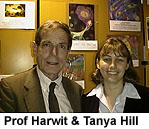Infrared astronomy has revolutionised and transformed the way we view
the makings of the Universe and our place in it. The advantage of infrared radiation is
that it can be detected from deep within distant, dust-shrouded regions that are
impenetrable to visible light. These new infrared observations now reveal the physical
processes which took place in the formation of galaxies and stars billions of years ago.
These sightings are enabling astronomers to reconstruct the early history of the
Cosmos, as it cooled to transform itself from a hot, blandly uniform fluid into the mass
of colliding galaxies, exploding stars and newly born planets we see swirling all around
us.
Listen to the talk
 You will need Real Player to listen to the talk
You will need Real Player to listen to the talk
 Introduction
Introduction
Tanya Hill, Astronomer, Melbourne Planetarium (1.25mins) 
Keynote speaker
Prof. Martin Harwit talks about:
- Infrared astronomy has made great advances in the last few years. (3.25mins)

- Infrared astronomers use heat sensors to observe the Universe. (.58secs)

- Atmospheric obscurations means infrared telescopes must be sent into space. (2.05mins)

- Different types of light: far-infrared, near-infrared, visible and ultraviolet. (2.05mins)

- The lastest infrared telescope in space - the Infrared Space Observatory (ISO)

